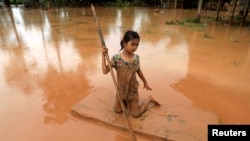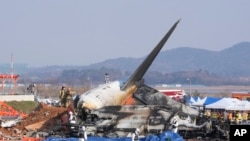ນຶ່ງປີຫຼັງຈາກເກີດໄພພິບັດເຂື່ອນແຕກຢູ່ທາງພາກໃຕ້ຂອງປະເທດລາວ ທີ່ໄດ້ເຮັດໃຫ້
ມີຜູ້ເສຍຊີວິດຫຼາຍສິບຄົນ ແລະຫຼາຍພັນຄົນບໍ່ມີທີ່ຢູ່ອາໄສ ບັນດາກຸ່ມປົກສິດທິມະນຸດ
ກຳລັງຮຽກຮ້ອງ ໃຫ້ບັນດາບໍລິສັດຕ່າງຊາດທີ່ຢູ່ເບຶ້ອງຫຼັງໂຄງການ 1 ພັນລ້ານໂດລາ
ດັ່ງກ່າວ ໃຫ້ການຊ່ວຍເຫຼືອຫຼາຍຂຶ້ນແກ່ຫຼາຍຮ້ອຍຄອບຄົວ ທີ່ຍັງພັກພາອາໄສຢູ່ໃນ
ບ່ອນທີ່ແອອັດແລະການປັນສ່ວນທີ່ບໍ່ພຽງພໍ.
ໃນຄ່ຳຄືນຂອງວັນທີ 23 ເດືອນກໍລະກົດ ປີ 2018 ສັນເຂື່ອນ ຂອງເຂື່ອນໄຟຟ້າເຊປຽນ
ເຊນ້ຳນ້ອຍ ໄດ້ແຕກ ຊຶ່ງໄດ້ສົ່ງກະແສນ້ຳໄຫຼລົງມາຖ້ວມສິບກວ່າໝູ່ບ້ານ. ຫຼາຍກວ່າ
7,000 ຄົນ ຢູ່ໃນປະເທດລາວ ແລະອີກຫຼາຍພັນຄົນຢູ່ໃນປະເທດກຳປູເຈຍ ທີ່ເປັນ
ເພື່ອນບ້ານໄດ້ຖືກບັງຄັບໃຫ້ຍົກຍ້າຍອອກຈາກບ້ານເຮືອນເຂົາເຈົ້າ.
ບ້ານເຮືອນແລະໄຮ່ນາຮົ້ວສວນໄດ້ຖືກນ້ຳພັດໄປ. ຫຼັງຈາກເກີດເຫດການດັ່ງກ່າວ ຜູ້
ລອດຊີວິດຄົນນຶ່ງໄດ້ກ່າວຕໍ່ ວີໂອເອ ວ່າ ນ້ຳໄດ້ໄຫຼລົງມາຖ້ວມບ້ານຂອງລາວ “ຄືດັ່ງ
ຊູນາມິ.”
ລັດຖະບານລາວໄດ້ແຈ້ງຈຳນວນຜູ້ເສຍຊີວິດຂັ້ນສຸດທ້າຍວ່າມີ 49 ຄົນແລະອີກ 22
ຄົນໄດ້ຫາຍສາຍສູນ ເຖິງແມ່ນວ່າ ບັນດາກຸ່ມປົກສິດທິມະນຸດກ່າວວ່າ ຈຳນວນທີ່ເປັນ
ທາງການ ອາດ “ຕ່ຳເກີນໄປໂພດ.”
ຊາວບ້ານຈຳນວນ 5,000 ຄົນ ທີ່ບໍ່ມີບ່ອນຢູ່ອາໄສຍັງພາກັນພັກຢູ່ຕາມສູນຊົ່ວຄາວ
ທ່າມກາງບັນຍາກາດທີ່ຮ້ອນເອົ້າຂອງປະເທດລາວ ຄັບແຄບແອອັດຢູ່ຕາມ ຕູບສັງກະ
ສີຢູ່ລອດຈາກການເງິນທີ່ໄດ້ຮັບບໍ່ເປັນປົກກະຕິ ແລະການແບ່ງປັນ ທີ່ບໍ່ພຽງພໍຈາກລັດ
ຖະບານ. ຈຳນວນນຶ່ງໄດ້ເອົາໄຖ ແລະແກ່ນພືດໃຫ້ ແຕ່ບໍ່ມີດິນແຫ່ງໃໝ່ທີ່ຈະໃຊ້ ໃນ
ຂະນະທີ່ດິນດອນບ່ອນປູກຝັງເກົ່ານັ້ນຍັງຖືກຖົມຢູ່ພາຍໃຕ້ຂີ້ຕົມ ແລະຊາກຫັກພັງ.
ມີລາຍງານວ່າ ບໍລິສັດຮ່ວມລົງທຶນ ທີ່ຢູ່ເບື້ອງຫຼັງການສ້າງເຂື່ອນໄຟຟ້າເຊປຽນ ເຊນ້ຳ
ນ້ອຍ ຫຼື PNPC ເລີ້ມສະເໜີການຊົດເຊີຍໃຫ້ແກ່ບັນດາຜູ່້ເຄາະຮ້າຍ ອີງຕາມທ່ານ
ນາງ Maureen Harris ຜູ້ອຳນວຍການໂຄງການເອເຊຍອາຄະເນ ຂອງອົງການແມ່
ນ້ຳສາກົນ ຊຶ່ງເປັນອົງການບໍ່ຫວັງຜົນກຳໄລ. ທ່ານນາງໄດ້ກ່າວໃນວັນອັງຄານທີ່ຜ່ານ
ມາຢູ່ບາງກອກ ໃນການເຜີຍແຜ່ລາຍງານຂ່າວ “ການບໍ່ຫົວຊາທີເປັນອັນຕະລາຍ: ການ
ຊັ່ງຊາຄວາມຮັບຜິດຊອບ ສຳລັບເຂື່ອນເຊປຽນ ເຊນ້ຳນ້ອຍແຕກ.”
ທ່ານນາງ Harris ກ່າວວ່າ “ແຕ່ວ່າບັນດາປະຊາຄົມ ມີລາຍງານວ່າພາກສ່ວນໃຫຍ່ ທີ່
ການສະເໜີຂອງການຊົດເຊີຍເຫລົ່ານີ້ຕ່ຳເກີນໄປ ເຂົາເຈົ້າບໍ່ໄດ້ນັບຢ່າງຖືກຕ້ອງຕໍ່ລາ
ຄາທີ່ແທ້ຈິງຂອງສິ່ງທີ່ໄດ້ເສຍຫາຍ ໃນກໍລະນີຊັບສິນ ແຕ່ຍັງຮວມທັງການສູນເສຍວິ
ຖີຊີວິດການເປັນຢູ່ ອັນເປັນຜົນຂອງການສູນເສຍ ຊັບສິນດັ່ງກ່າວ.”
ໃນຂະນະທີ່ບັນດາຜູ້ເຄາະຮ້າຍບາງຄົນພາກັນປະຕິເສດບໍ່ຕໍ່ການສະເໜີນັ້ນ ແຕ່ບາງ
ຄົນພັດຮັບເອົາ. ລັດຖະບານກ່າວວ່າ ຍັງຈະໃຊ້ເວລ າອີກສີ່ຫາຫ້າປີ ກ່ອນ ບ່ອນຢູ່
ອາໄສຖາວອນຈະເສັດສິ້ນ.
One year after a catastrophic dam collapse in southern Laos killed dozens of people and displaced thousands, rights groups are demanding that multinational companies behind the $1 billion project do more for the hundreds of families still living in cramped shelters on meager rations.
On the night of July 23, 2018, an auxiliary — or saddle — dam of the Xe Pian-Xe Namnoy hydropower project collapsed, sending a wall of water crashing through more than a dozen villages. More than 7,000 people in Laos and thousands more in neighboring Cambodia were forced from their homes.
Homes and farms were wiped out. In the aftermath, one survivor told VOA that the water hit his village "like a tsunami."
The Lao government put the final death toll at 49, with another 22 missing, although rights groups say the official tally may be a "gross underestimation."
FILE - Villagers take refuge on a rooftop above floodwaters from a collapsed dam in the Attapeu district of southeastern Laos, July 24, 2018.
Some 5,000 displaced villagers are still living in temporary camps in Laos in sweltering, tightly packed tin shacks, surviving on irregular allowances and thin rations from the government. Some have been given plows and seeds, but no new land on which to use them, while much of the old farmland remains buried under silt and debris.
The joint venture behind the dam, the Xe Pian-Xe Namnoy Power Company, or PNPC, has reportedly started offering victims compensation, according to Maureen Harris, Southeast Asia program director for International Rivers, a non-profit organization. She spoke Tuesday in Bangkok at the release of a new report, "Reckless Endangerment: Assessing Responsibility for the Xe Pian-Xe Namnoy Dam Collapse."
"But the communities report for the most part that these offers of compensation are too low; they don't properly account for the real value of what's been lost in terms of the property, but also the lost livelihoods as a result of losing that property," Harris said.
While some victims are refusing the offers, others have relented. The government says it will be four or five years before a permanent resettlement site is ready.
Rights groups say the many companies building and backing the dam, which is slated for completion later this year, are bound by international law to do more for the victims, and that their governments should compel them to follow through.
To date, none of the companies has been held accountable for the collapse, despite mounting evidence that the lead developer and builder, South Korea's SK Engineering & Construction, compromised safety for profit.
An independent investigation commissioned by the Lao government ruled out force majeure — an unforeseen "act of God." Authorities have yet to release the investigation report but said the expert panel decided that a poor foundation was "the major cause" of the collapse.
A Stanford University scientist, who parsed data from the dam, concluded that the reservoir the saddle dam was holding back had been built over a sinkhole, causing the dam to sink and crack and finally fail when the rising waters mounted the top. A company document leaked by a Korean lawmaker also showed that all five saddle dams were several meters lower than intended by the original design plan and made of different material, saving millions of dollars.
"So there is growing evidence basically from different quarters that suggests that the lead developer ... may have caused the collapse by their actions and inactions," Harris said.
Of the other PNPC partners, the rights groups also place much of the burden on Thailand's Ratchaburi Electricity Generating Holding, the project's construction supervisor responsible for overseeing SK Engineering's work.
SK Engineering has rejected the independent investigation's findings and denied responsibility. The company has said it followed industry standards, but failed to offer an alternate explanation for the collapse.
SK Engineering did not reply to a request for comment from VOA.
A public relations officer for Ratchaburi declined to answer any questions and referred all inquiries to PNPC. A project manager for PNPC also declined to comment.
Lao government officials could not be reached.
Citing an industry source, rights groups say the project took out a massive insurance policy that includes roughly $50 million in liability coverage that the affected families could tap into, some of it from U.S. insurance company AIG.
"There is a pot of insurance money here for exactly this kind of situation, and the affected people should have the capacity to claim against this insurance to remediate them for the losses," said Craig Bradshaw, Southeast Asia legal coordinator for Inclusive Development International, which co-authored the report.
Kongvilay Inthavong and his wife, Thongla, clean up their house as the floodwaters start to recede in Sanamxay district, Attapeu province, Laos, July 26, 2018.
Harris and Bradshaw said their groups were in talks with lawyers on the potential for filing legal claims, most likely in South Korea, but possibly in Thailand as well.
Rights groups are urging the companies to halt construction until those affected are made whole again. Without a full and public accounting of exactly what went wrong, they say, locals are also left to wonder if the other four saddle dams holding back the reservoir face the same risks as the one that collapsed.
Premrudee Daorung, a coordinator with the Laos Dam Investment Monitor, a grass-roots group set up in the wake of the collapse, said the group hoped the fallout would also convince the government to reconsider its ambitious — critics would say overly so — hydropower plans.
"One of our first proposals, or the hope, was that Laos might be able to make use of the Xe Pian-Xe Namnoy case in order to turn the direction of the plan to become 'the battery of Asia,' to review that plan," she said.
But with 27 more dams in the works and hundreds more still on the drawing board, she worried, those hopes appear dashed.










